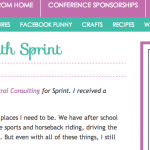 Earlier this year the FTC released new guidelines on how advertisers are to display any disclaimers associated with their advertisements which now include social media including Twitter. With this release The Federal Trade Commission is on a mission to crack down on false advertising that could mislead a product or service for consumers. You see and hear disclaimers all the time while watching ads. When you see a car commercial and it notes “professional driver on a closed course” along with a massive paragraph at a size 4 font about the amount of cash you need to put down to get a lease for a month. Or you listen to the radio and at the end of a commercial someone dumps all the rules and regulations on you faster than the Micro Machines Guy. Either way being in Marketing means you need to pay attention to the same guidelines and so here they are.
Earlier this year the FTC released new guidelines on how advertisers are to display any disclaimers associated with their advertisements which now include social media including Twitter. With this release The Federal Trade Commission is on a mission to crack down on false advertising that could mislead a product or service for consumers. You see and hear disclaimers all the time while watching ads. When you see a car commercial and it notes “professional driver on a closed course” along with a massive paragraph at a size 4 font about the amount of cash you need to put down to get a lease for a month. Or you listen to the radio and at the end of a commercial someone dumps all the rules and regulations on you faster than the Micro Machines Guy. Either way being in Marketing means you need to pay attention to the same guidelines and so here they are.
Disclosures that are required to prevent an advertisement from being deceptive, unfair, or otherwise violative of a Commission rule, must be presented “clearly and conspicuously.”18 Whether a disclosure meets this standard is measured by its performance — that is, how consumers actually perceive and understand the disclosure within the context of the entire ad. The key is the overall net impression of the ad — that is, whether the claims consumers take from the ad are truthful and substantiated.19 If a disclosure is not seen or comprehended, it will not change the net impression consumers take from the ad and therefore cannot qualify the claim to avoid a misleading impression

What does this mean? Well, lets say you were a car salesmen and you made an advertisement that said you would sell a car for 1,395 bananas. Something funny and ridiculous! Even if it’s a typo on your part, without a disclosure, you better be ready to end up waste deep in bananas as this car salesman from Connecticut was after his business was charged with false advertising. Story Via UCONN Archives.
What does this mean for twitter?
What this means is if you are at all trying to offer products, services, or reviews that you have received any compensation for you need to be completely transparent and up front of this in a clear and concise way that is obvious to the average consumer. For example, if you are a photographer and Canon sends you a new camera to review for your personal blog, you must disclose, either in the title of the post, or in an obvious area that this is a “sponsored” or paid post and that you have received compensation for your comments. A great example on giving proper disclosure is how this post from The Springmount 6 Pack.
You can see in the tweet included the hastag #SPONSORED right in the message, and on the landing page the blog post discloses that they had received the product they are reviewing for free from the provider. Some advertisers have also gone the route to prefix their tweets with “Ad: OFFER MESSAGE” which is also satisfactory to the FTC, however just adding the hashtag “#spon” does not satisfy them as they feel the “average consumer” may not understand that language. Along with worrying about properly disclosing, you are also tasked with employing best practices to ensure that the re-sharing of your content should also include your disclosure as other people may delete that section when they share your message.
Now this seems like a lot of work but again like the banana story above, this is meant to help protect the business as well as the consumer. Granted it’s much more weighted towards the consumer. Being in marketing and advertising this may seem like a huge task but remember, as stated on page 7 of the new guidelines:
There is no set formula for a clear and conspicuous disclosure; it depends on the information that must be provided and the nature of the advertisement.
Read about the release and download the new guidelines here.


